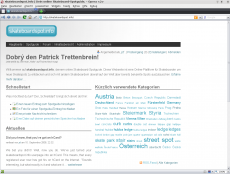Browser Configuration/Opera: Difference between revisions
No edit summary |
Icew0lfBlade (talk | contribs) Cleaned things up and corrected spelling/grammar where necessary. |
||
| Line 1: | Line 1: | ||
This tutorial explains how to configure Opera so that it will look like the rest of your KDE applications. To do this, we'll need to install the Opera Oxygen Project skin and change Opera's default font to the one which KDE uses. | |||
'''Please note:''' This tutorial | '''Please note:''' This tutorial is written for Opera 9.5 or later. Make sure that you're using KDE's default icon theme, Oxygen, since the Opera Oxygen Project skin uses icons from Oxygen. | ||
== Step 1: Installing the Skin == | |||
Open Opera and navigate to the following link: | |||
[http://my.opera.com/community/customize/skins/info/?id=8141 http://my.opera.com/community/customize/skins/info/?id=8141] | |||
Click "Download Skin" to install the Opera Oxygen Project skin. | |||
== Step 2: Applying the Skin == | |||
Go to Tools -> Appearance. | |||
[ | In the "Skins" box, you will see a list of all the skins that are currently installed. Click on "opera_oxygen_project_[version]" to apply the Opera Oxygen Project skin to Opera. | ||
== Step 3: Changing the Font == | |||
Go to Tools -> Preferences. Click on the "Web Pages" tab. | |||
Opera has two default fonts - the normal font and the monospace font. You can change the default fonts by clicking on them. Change the normal font to ''DejaVu Sans'' and change the monospace font to ''DejaVu Sans Mono''. | |||
That's it! Now Opera will look and feel just like your other KDE applications. | |||
[[Image:Opera-kde4.png|center|230px]] | |||
== Source == | == Source == | ||
This tutorial is based on | This tutorial is based on Patrick Trettenbrein's blog entry entitled [http://skateboardspot.info/cat/blog/displayOne/31 “How to make Opera 9.5 look native in KDE 4”]. | ||
Revision as of 22:12, 25 September 2008
This tutorial explains how to configure Opera so that it will look like the rest of your KDE applications. To do this, we'll need to install the Opera Oxygen Project skin and change Opera's default font to the one which KDE uses.
Please note: This tutorial is written for Opera 9.5 or later. Make sure that you're using KDE's default icon theme, Oxygen, since the Opera Oxygen Project skin uses icons from Oxygen.
Step 1: Installing the Skin
Open Opera and navigate to the following link:
http://my.opera.com/community/customize/skins/info/?id=8141
Click "Download Skin" to install the Opera Oxygen Project skin.
Step 2: Applying the Skin
Go to Tools -> Appearance.
In the "Skins" box, you will see a list of all the skins that are currently installed. Click on "opera_oxygen_project_[version]" to apply the Opera Oxygen Project skin to Opera.
Step 3: Changing the Font
Go to Tools -> Preferences. Click on the "Web Pages" tab.
Opera has two default fonts - the normal font and the monospace font. You can change the default fonts by clicking on them. Change the normal font to DejaVu Sans and change the monospace font to DejaVu Sans Mono.
That's it! Now Opera will look and feel just like your other KDE applications.

Source
This tutorial is based on Patrick Trettenbrein's blog entry entitled “How to make Opera 9.5 look native in KDE 4”.
